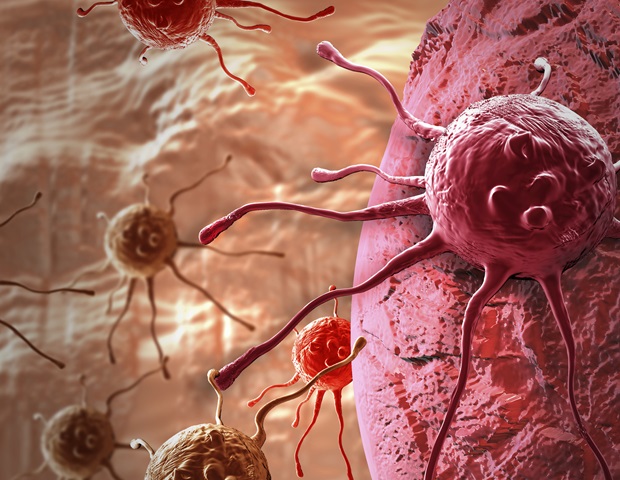Study uncovers 'cell of origin' of the second most common lung cancer

The 'cell of origin' of the second most common lung cancer and the way that it becomes dominant in the lung have been discovered, in a new study in mice and humans from researchers at UCL, the Wellcome Sanger Institute and the University of Cambridge. The study, published in Science, found that a population of basal cells found in the trachea (windpipe) outcompetes other cell types and becomes dominant, eventually invading and occupying large areas of the lung. It is from these cells, which express a gene called Krt5 that helps to build the structure of cells, that lung squamous cell carcinoma (LUSC) eventually develops. The research team say the findings raise the prospect of earlier detection, and perhaps even prevention, of lung cancer in future. Lung cancer remains the leading cause of cancer-related deaths worldwide, frequently presenting at a late, incurable stage. LUSC is the second most common subtype of lung cancer and develops when cells accumulate continuous damage from exposure to toxins, usually from smoking. As a result, the cells become increasingly disorganised and eventually form areas of damaged tissue (precancerous lesions) in the lining of the airways. But the biological changes that occur in the cells during the transition from a normal to a precancer state are unknown. In this study, we set out to understand the changes that occur prior to the development of lung squamous cell carcinoma and which cell type this cancer arises from. We found that a subset of cells expressing the gene Krt5 becomes dominant and starts pushing out normal cells. This expansion becomes dramatic and eventually the descendants of just a few cells that originated in the trachea invade and conquer normal cells, in some cases going on to populate whole lobes of the lung. It is these cells that eventually form tumours. By understanding the 'cell of origin' where these changes begin and how they develop, the ambition is that we will be able to design strategies to prevent lung cancer occurring in the first place or at least detect it much earlier." Professor Sam Janes, senior author of the study from UCL Division of Medicine To investigate the origins of LUSC, the team labelled Krt5-expressing basal cells in the trachea of two groups of mice so that the descendants of these cells could be tracked over time. One group of mice was then exposed to a carcinogen (cancer-causing substance), to observe how this affected the normal behaviour of the cells in the airways. In this group, some of these basal cells gradually multiplied before spreading into the lungs, whereas in the control group the basal cells and their descendants remained in their original location in the trachea. Dr Sandra Gómez-López, first author of the study from UCL Division of Medicine, said: "Under normal circumstances the lining of the airways is made up of basal stem cells, as well as luminal cells helping to protect the lung. When basal cells divide, they give rise to new basal cells or to luminal cells. Luminal cells perform key functions in the airways, with secretory cells producing protective substances, or ciliated cells that help move inhaled particles. "There is a natural balance between the different cell populations and types, but when these cell populations are exposed to carcinogens like those found in tobacco smoke, this balance is disrupted. Our experiments have shown that populations of cells originating from just a few damaged basal cells in the trachea gradually become dominant, taking over large areas of the lung." Additional single-cell RNA sequencing of tracheal cells from mice (comparing healthy control cells vs those exposed to a carcinogen) and humans (comparing cells from non- vs current smokers) revealed that as these damaged basal cells colonise the airways, a population of transitional cells expressing a different gene, Krt13, also becomes more abundant, while some luminal cell types become scarce. The researchers also performed DNA sequencing of human trachea and lung samples from people who had smoked. As in the mouse experiment, the results showed that cells from separate precancerous lesions, sometimes in both lungs of the same person, were again descended from the same damaged basal cell. The researchers aim to use this knowledge to develop tests to detect the earliest steps towards lung cancer that occur when cells appear normal, in the hope of facilitating earlier interventions. Understanding how these cells become so dominant in the lung may also enable the development of new drugs to stop this occurring, raising the prospect of preventing these cancers in the future. Dr Talisia Quallo, Research Programme Manager in Early Detection and Diagnosis at Cancer Research UK, said: "Lung cancer is the most common cause of cancer death in the UK, accounting for one in five of all cancer deaths. The disease is often caught late, so it's important that we find ways to detect lung cancer earlier, when there is the best chance of treating it successfully. "This research reveals the early cellular steps preceding the development of lung squamous cell carcinoma, a common form of lung cancer, and identifies the cell type from which this cancer develops. More research is needed, but in future this information could help scientists to develop new ways to detect the disease earlier or even prevent it from occurring." Professor Peter Campbell, an author of the study from the University of Cambridge and previously at the Wellcome Sanger Institute, said: "Understanding why lung cancer develops where it does can help researchers and clinicians find new ways to predict or detect tumours early, helping to give the best possible outcomes. "For me, one of the most interesting aspects of our research was discovering that squamous cell lung cancer develops from a precursor cell once it has found a particular environment in the lung, with space to grow and genetically change. We found that when these specific environments arise, they dramatically increase the risk of lung cancer. In the future, it could be possible to look for these sections in those at risk of cancer and develop treatment plans to prevent or treat lung cancer as early as possible."

















